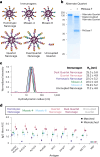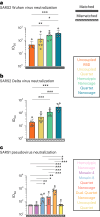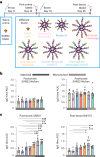Proactive vaccination using multiviral Quartet Nanocages to elicit broad anti-coronavirus responses
- PMID: 38710880
- PMCID: PMC11329374
- DOI: 10.1038/s41565-024-01655-9
Proactive vaccination using multiviral Quartet Nanocages to elicit broad anti-coronavirus responses
Abstract
Defending against future pandemics requires vaccine platforms that protect across a range of related pathogens. Nanoscale patterning can be used to address this issue. Here, we produce quartets of linked receptor-binding domains (RBDs) from a panel of SARS-like betacoronaviruses, coupled to a computationally designed nanocage through SpyTag/SpyCatcher links. These Quartet Nanocages, possessing a branched morphology, induce a high level of neutralizing antibodies against several different coronaviruses, including against viruses not represented in the vaccine. Equivalent antibody responses are raised to RBDs close to the nanocage or at the tips of the nanoparticle's branches. In animals primed with SARS-CoV-2 Spike, boost immunizations with Quartet Nanocages increase the strength and breadth of an otherwise narrow immune response. A Quartet Nanocage including the Omicron XBB.1.5 'Kraken' RBD induced antibodies with binding to a broad range of sarbecoviruses, as well as neutralizing activity against this variant of concern. Quartet nanocages are a nanomedicine approach with potential to confer heterotypic protection against emergent zoonotic pathogens and facilitate proactive pandemic protection.
© 2024. The Author(s).
Conflict of interest statement
M.R.H. is an inventor on a patent on spontaneous amide bond formation (EP2534484) and a SpyBiotech co-founder and shareholder. M.R.H. and A.H.K. are inventors on a patent on SpyTag003:SpyCatcher003 (UK Intellectual Property Office 1706430.4). P.J.B. and A.A.C. are inventors on a US patent application filed by the California Institute of Technology that covers the methodology to generate cross-reactive antibodies using Mosaic nanoparticles. P.J.B. and A.A.C. are inventors on a US patent application filed by the California Institute of Technology that covers the monoclonal antibodies elicited by vaccination with Mosaic nanoparticles described in this work. P.J.B., A.A.C. and J.R.K. are inventors on a US patent application filed by the California Institute of Technology that covers the methods of isolating cross-reactive antibodies by vaccination with Mosaic nanoparticles. All other authors have no competing interests to declare.
Figures





Update of
-
Multiviral Quartet Nanocages Elicit Broad Anti-Coronavirus Responses for Proactive Vaccinology.bioRxiv [Preprint]. 2023 Feb 24:2023.02.24.529520. doi: 10.1101/2023.02.24.529520. bioRxiv. 2023. Update in: Nat Nanotechnol. 2024 Aug;19(8):1216-1223. doi: 10.1038/s41565-024-01655-9. PMID: 36865256 Free PMC article. Updated. Preprint.
References
MeSH terms
Substances
Grants and funding
- P01 AI165075/AI/NIAID NIH HHS/United States
- NIH AI165075/Foundation for the National Institutes of Health (Foundation for the National Institutes of Health, Inc.)
- BB/S007369/1/RCUK | Biotechnology and Biological Sciences Research Council (BBSRC)
- 2018-I2M-2-002/Chinese Academy of Medical Sciences (CAMS)
LinkOut - more resources
Full Text Sources
Medical
Research Materials
Miscellaneous

